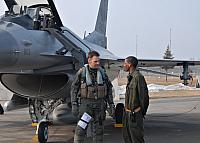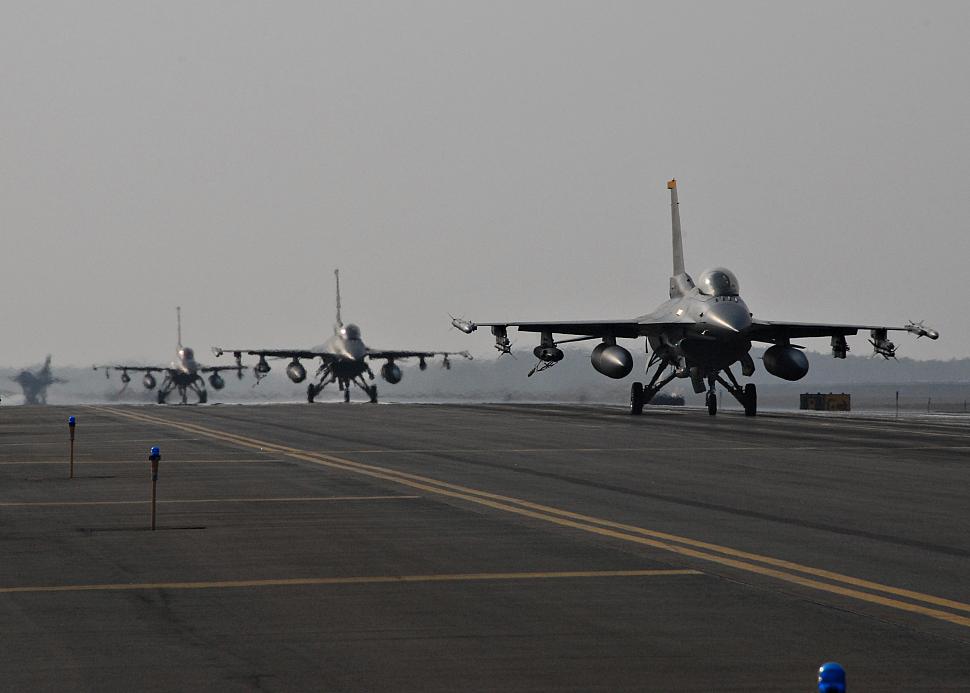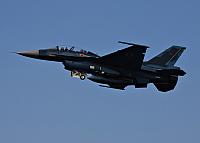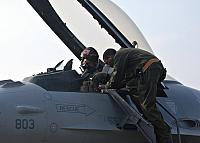Fighter Jet News
F-16 Fighting Falcon News
Seikan War provides joint bilateral training
March 18, 2008 (by
SSgt. Rachel Martinez) -
Members of the US Air Force and Japan Air Self Defense Force (JASDF) took to the skies for a joint and bilateral air exercise March 10 to 13.
Seikan War incorporates F-16s, F-15s, F-4s and F-2s from the U.S. and Japanese fleet into air to air combat scenarios, to include a large force exercise.
This exercise is not the only chance that U.S. Air Force pilots get to fly with their Japanese counterparts, but it is one of the few chances to do it so close to home.
"The U.S. uses the airspace to the west and JASDF uses the airspace to the east, but we combined the airspace for this exercise," said Captain Byrne.
During Seikan War, aircraft simulating enemy aircraft, also known as Red Air, are challenged by Blue Air aircraft. The F-15s participating are primarily serving as the Red Air; however Misawa's F-16s were given a chance to be Red Air during the last day of the exercise.
"Depending on the scenario, Red Air can be more fun, but Blue Air is more challenging," said Captain Byrne. "You have to coordinate with more aircraft."
Whether Red Air, Blue Air, or on the ground, the training is valuable to those participating.
"This is excellent training," said Capt. Christopher Byrne, 14th Fighter Squadron. "It's invaluable to see the other aircraft in the air. Fighting other aircraft, seeing something different in the air - it is a lot of fun."
According to the captain, the language difference between the two countries does not present much of a problem.
"The language barrier does come into play, but the Japanese are very good at English - don't let them tell you they aren't," he said. "English is the international flying language."
Interaction between the two air forces happens not only in the air, but also on the ground.
"Japanese air controllers get to control our aircraft at times and our controllers get to control Japanese aircraft at times," explained Captain Byrne. "This increases our proficiency and the Japanese controller's proficiency."
Debriefs were also conducted jointly. Pilots were able to sit-in on the countries debriefs.
"Debriefs are extremely different in both countries," said Captain Byrne. "There is no score for the exercise, but during the debriefs, we highlight the positives and negatives."
The exercise concluded with an social between both countries. This allowed the pilots, maintenance personnel and air traffic controllers to interact in a social environment and build upon the U.S. and Japan relations.
Seikan War is held annually or as requested by one of the participating parties.
This exercise is not the only chance that U.S. Air Force pilots get to fly with their Japanese counterparts, but it is one of the few chances to do it so close to home.
"The U.S. uses the airspace to the west and JASDF uses the airspace to the east, but we combined the airspace for this exercise," said Captain Byrne.
During Seikan War, aircraft simulating enemy aircraft, also known as Red Air, are challenged by Blue Air aircraft. The F-15s participating are primarily serving as the Red Air; however Misawa's F-16s were given a chance to be Red Air during the last day of the exercise.
"Depending on the scenario, Red Air can be more fun, but Blue Air is more challenging," said Captain Byrne. "You have to coordinate with more aircraft."
Whether Red Air, Blue Air, or on the ground, the training is valuable to those participating.
"This is excellent training," said Capt. Christopher Byrne, 14th Fighter Squadron. "It's invaluable to see the other aircraft in the air. Fighting other aircraft, seeing something different in the air - it is a lot of fun."
According to the captain, the language difference between the two countries does not present much of a problem.
"The language barrier does come into play, but the Japanese are very good at English - don't let them tell you they aren't," he said. "English is the international flying language."
Interaction between the two air forces happens not only in the air, but also on the ground.
"Japanese air controllers get to control our aircraft at times and our controllers get to control Japanese aircraft at times," explained Captain Byrne. "This increases our proficiency and the Japanese controller's proficiency."
Debriefs were also conducted jointly. Pilots were able to sit-in on the countries debriefs.
"Debriefs are extremely different in both countries," said Captain Byrne. "There is no score for the exercise, but during the debriefs, we highlight the positives and negatives."
The exercise concluded with an social between both countries. This allowed the pilots, maintenance personnel and air traffic controllers to interact in a social environment and build upon the U.S. and Japan relations.
Seikan War is held annually or as requested by one of the participating parties.
Courtesy of 35th Fighter Wing Public Affairs
Additional images:


Lt. Col. Charles Toplikar, 14th FS commander, talks with A1C. Alvin Felder, 35th AMXS crew chief, during a pre-flight inspection on March 11th, 2008. Colonel Toplikar and other 14th FS members participated in Seiken War, a joint bilateral air exercise, with the JASDF. [USAF photo by SSgt. Rachel Martinez]
Related articles:
Forum discussion:
Tags
- 14th FS train with JASDF in Hyakuri (2008-01-18)
- Misawa airmen compete for weapons-loading title (2007-12-03)
- 14th FS exercises with JASDF at Hyakuri (2007-10-29)
- F-16 Fighting Falcon news archive
Forum discussion:
- Start a discussion about this article in the F-16.net forum.
Tags



